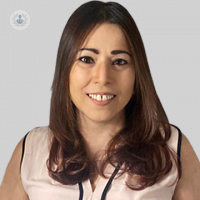Migraine vs headache: what is the difference?
Written in association with:The terms "migraine" and "headache" may be considered interchangeable by some people, however, there is vast differences between the two conditions. Leading consultant neurologist Dr Mona Ghadri-Sani is here to demonstrate the differences and to explain what happens during a migraine.
What is the difference between a migraine and a headache?
Headaches can have several different causes. They can be caused by many different things, the majority being primary headaches. Primary headaches refer to headaches where there is no underlying cause.
Occasionally headaches can be caused be something in the brain such as an aneurysm or a brain tumour whereas a migraine is a specific type of a headache disorder.
Migraine is one of the primary headache disorders and it has specific diagnostic criteria, associated features and treatment.
Migraine is just one type of a headache whereas a headache is vague and can be secondary to a lot of different causes.

What occurs in the brain during a migraine? Is memory affected?
A lot happens when a patient is having a migrane attack and it all starts not only within the brain itself but also within the nerves, around the scalp, neck, shoulders and face.
The trigeminal nerve is a nerve which is often a causing factor for migraines. This nerve supplies the side of the head and face.
If this nerve becomes activated it becomes irritable, hypersensitive and overactive. It then begins to send an increasing number of signals to the brain and through a complex system, the brain becomes sensitive and overactive.
The patient who is having an attack can then have a lot of different symptoms and difficulty with memory may be one of those attacks.
In particular, patients can have difficulty with memory even between attacks, not just during attacks. They can become forgetful and misplace things.
What are common migraine symptoms?
The most common migraine symptoms are feeling nauseous and sick. These symtpoms may be so severe that they can result in vomiting.
As mentioned above, during a migraine, the nerves are hypersensitive and overactive, sending too many signals to the brain. As a result, everything can become too much. You can become sensitive to light and noise and with too much movement you can become dizzy.
Additionally, with migraines you feel nauseous, as if you are on a boat or rocking.
Commonly with migraines, you can get visual symptoms; blurring of vision or floaters. Some parts of your vision may even be missing or you can have little holes in your vision or it can look shattered as if you are looking through shattered glass.
In addition, you can have pain going into your neck. Many patients suffeirng with migraine get neck pain and pain into the shoulders.
As mentioned above, it can affect your memory; you become forgetful and you can’t concentrate therefore your concentration is poor. You can also feel numbness and tingling, affecting various parts of the body including the face, hands and feet.
You can also have patches of pain around your scalp or the arms and legs. Even touching the area can be tender and painful.
Do all migraines occur with an aura?
Migraines do not always occur with an aura. The majority of migraines occur without an aura.
An aura can be anything from, for example, a visual disturbance that you get ahead of having the actual headache or common things such as flashing lights, shattered glass, pictures or zigzag lines. The aura may be a visual aura or numbness, tingling or weakness.
An aura refers to the symptoms that proceed the actual headache phase. They can last anywhere from minutes to hours and can even proceed the headache again within hours or sometimes within minutes.
Some patients experience an aura and then immediately get a headache.
What can be done to relieve a migraine?
The best thing to relieve a migraine is to prevent a migraine.
The best method of prevention is to ensure that you’re hydrated, therefore you should avoid taking caffeine fluids or products which contain caffeine i.e. tea, coffee, fizzy drinks and chocolate.
It is also important to avoid painkillers as much as possible because painkillers themselves make migraines worse and can cause chronification of headaches. This means that they can become more and more severe and frequent after taking painkillers.
When you are in the midst of a migraine attack, up to twice per week you can take painkillers. There are various migraine painkillers available including simple painkillers including paracetamol and asprin but there are also different specific migraine painkillers, which are a group of drugs called triptans. However, doctors do not recommend taking painkillers regularly and again, recommend that they should only be taken a miniumum of twice per week.
With regard to prevention, lifestyle changes are recommended but it is also important to start on a preventative medication, where you take this medication on a regular basis to reduce the severity and the frequency of the attacks.
If you are suffering from migraines and would like to book a consultation with Dr Ghadiri-Sani, aimply visit her Top Doctors profile today.


